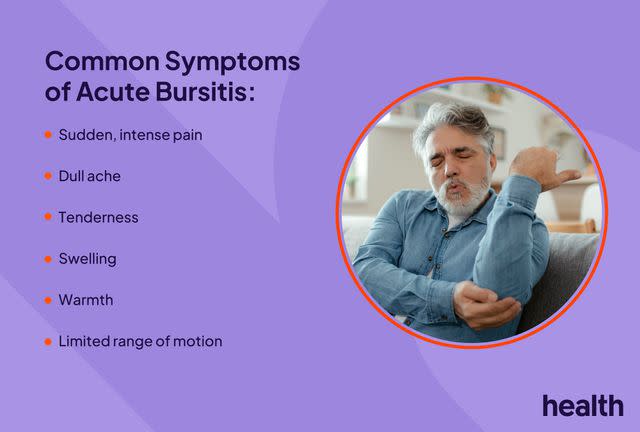Signs and Symptoms of Bursitis
Medically reviewed by David Ozeri, MD
Bursitis is the inflammation of a bursa, which is a fluid-filled sac between the muscles, tendons, skin, and bones near your joints. Over 150 bursae in your body act as cushions between moving body parts to minimize friction and make it easier for you to move. But when bursitis develops, the inflamed bursa swells and often causes intense, sharp pain that lasts for a few days and gradually turns into a dull ache.
This condition can affect any bursa in your body, but symptoms often affect the shoulder, hip, knee, elbow, and feet. Bursitis can limit your range of motion in the affected area, and symptoms often worsen with movement and improve with rest. It's also worth noting that bursitis may be acute (short-term), recurrent (affecting the same area more than once), or chronic (long-term).

Design by Health
Acute Bursitis Symptoms
Acute bursitis develops suddenly, usually due to a traumatic injury, infection, or certain types of arthritis (e.g., gout). Chronic overuse or repetitive movements (such as frequent kneeling) can also lead to acute bursitis. This type of bursitis typically occurs near a joint, like the elbow or knee. Fortunately, symptoms typically resolve within a few days with rest or treatment.
Common symptoms of acute bursitis may include:
Sudden, intense pain: Initial bursitis pain often feels sharp, which may worsen with movement and improve with rest
Dull ache: After a few days of sharp pain, bursitis may gradually become more dull
Tenderness: The affected area may feel sensitive and sore to touch, especially in areas around a joint
Swelling: The inflamed bursa may cause noticeable swelling, puffiness, or redness around the joint
Warmth: The affected area may feel warm to the touch compared to surrounding areas of your skin
Limited range of motion: Inflammation can restrict movement in the affected joint—and depending on which bursa is inflamed, it may be difficult to bend, extend, or fully rotate your joint
In some cases, acute bursitis can recur and affect the same bursa. Strengthening and stretching exercises can help prevent repeat bursitis episodes.
Chronic Bursitis Symptoms
Chronic bursitis is long-term inflammation of a bursa, which may initially last several months and frequently recur. With this condition, you may also experience flares (or periods with more active symptoms) which can last a few days to a couple of weeks. Symptoms may develop gradually and worsen over time due to repetitive motions that can irritate the bursa (e.g., frequently bending down to pick up heavy items). Symptoms include:
Dull or achy pain: The pain is often persistent, but may worsen at night or during physical activities
Stiffness: The affected joint may feel stiff, especially in the morning or after periods of inactivity
Loss of flexibility: The range of motion in the affected joint may decrease and affect your ability to carry out daily activities
Crepitus: A grating, grinding, or crackling sound or sensation when you move the affected joint
Muscle weakness: When chronic bursitis limits your movements, muscle atrophy (loss of muscle mass) can occur and cause weakness and loss of muscle tone
Do Bursitis Symptoms Differ by Location?
The core symptoms of bursitis—pain, limited range of motion, and tenderness—are the same no matter which bursa is inflamed. However, symptoms may affect you differently depending on the location and function of the affected joint. For example, hip bursitis sometimes causes pain that radiates down the outside of the thigh. Foot bursitis can make walking, running, or standing for long periods difficult.
When to Contact a Healthcare Provider
Symptoms of bursitis often resolve with rest and self-care measures, such as ice and heat therapy, and avoiding or restricting movements that worsen the pain. However, it is important to see a healthcare provider for diagnosis and treatment if you experience any of the following:
Sudden onset of intense pain, particularly after an accident or injury
Persistent redness, swelling, or warmth, along with fever and chills
Inability to move the affected joint
Pain that persists or worsens even with at-home treatments
Questions to Ask Your Provider
You may want to prepare a list of questions to ask when you see your healthcare provider for a possible bursitis diagnosis. Here are some suggestions:
Could my joint stiffness be a symptom of a different condition, such as arthritis?
What treatment options are available to relieve pain and swelling?
How long will it take for my pain to go away?
What do you think may have caused my bursitis?
Are there lifestyle modifications or exercises you recommend to prevent bursitis in the future?
A Quick Review
Bursitis is the inflammation of a fluid-filled sac (called the bursa) that cushions your body’s bones, muscles, tendons, and skin. Symptoms of bursitis may include redness, swelling, and sharp pain. Over time, bursitis pain may feel like a dull ache, and you may experience a limited range of motion in the affected joint. Acute bursitis resolves quickly, while chronic bursitis can persist for months. To relieve symptoms, it's important to see your healthcare provider for testing and treatment.
Frequently Asked Questions
Do symptoms of bursitis go away on their own?
Bursitis symptoms often improve with rest and home care, like icing the affected area and over-the-counter nonsteroidal anti-inflammatory drugs (NSAIDs) like Advil (ibuprofen). If symptoms do not improve with self-care measures, see a healthcare provider to discuss treatment options.
How serious are bursitis symptoms?
Bursitis symptoms are not life-threatening, but prolonged pain and inflammation can significantly affect your mobility and ability to carry out daily activities. Over time, chronic bursitis can lead to muscle atrophy (loss of muscle mass) and weakness.
What triggers bursitis symptoms?
Repetitive movements, overuse of the affected joint, poor posture, acute injury, and underlying conditions like arthritis and diabetes can trigger inflammation in the bursa and cause bursitis symptoms to develop.
For more Health.com news, make sure to sign up for our newsletter!
Read the original article on Health.com.

